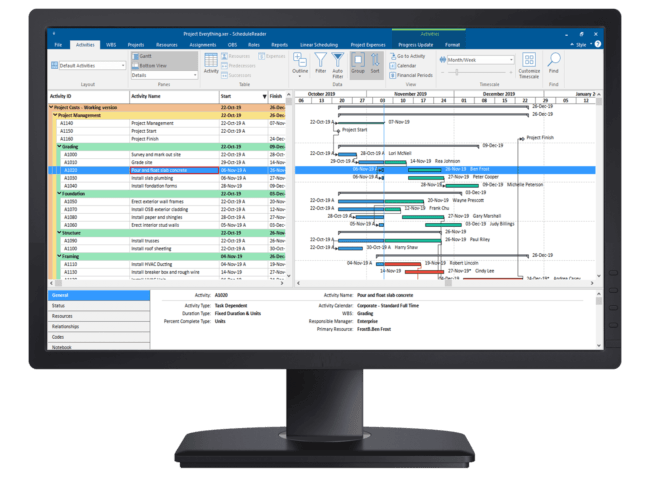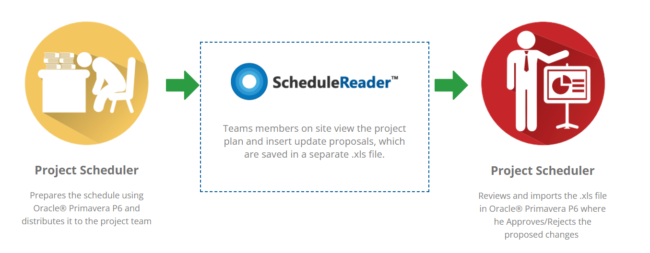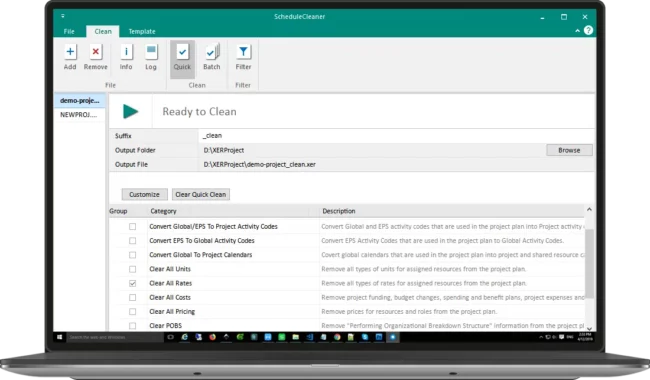Learning Primavera P6 might seem like a time-consuming and difficult task if you are getting introduced to the software now. Primavera P6, with its many functionalities can seem complicated to the project management professionals starting to work in it, however, as soon as some of the basics are learnt you learn and get accustomed to the most basic and vital functions, managing the rest is pretty simple and straightforward.
What is Primavera P6
Primavera PPM is the standard and most widely used enterprise project portfolio management software for planning and managing large scale projects across the Construction, Oil, Gas, Energy, Manufacturing, and similar industries, known to encompass complex projects.
The software is a powerful tool capable of supporting the prioritization, planning and management of large-scale and complex projects, programs, and project portfolios from end-to-end.
The Primavera suit of tools, developed by the Oracle® corporation comprises of several tools, but when we are referring to Primavera P6, we are mostly talking about the on-premises version of the software Primavera P6 Professional and EPPM, its web-based counterpart.
Becoming proficient with the Primavera P6 software is a skill that every scheduler working within the above-mentioned industries should possess, and learning how to use the software can greatly benefit a project scheduler’s career.
How long does it take to learn Primavera P6?
The time it takes to learn Primavera P6, like any software or skill, can vary widely, depending on several factors, mainly your prior experience with project management software, your familiarity with similar tools, your pace of learning, and the complexity of the projects you intend to manage and schedule using Primavera P6. Here’s a general breakdown of what can be expected:
- Basic Proficiency (2-4 weeks) – If you have prior experience with project management software and scheduling tools, you can gain basic proficiency rather quickly. The Basic Proficiency stage involves the user interface, navigation, creating simple project schedules, defining activities and relationships between them, and setting up basic resources and calendars.
- Intermediate Skills (2-4 months) – To become more proficient and use this software effectively for medium-sized project, you will need to invest more time. During this stage, you will get accustomed to advanced scheduling techniques, resource management, tracking progress and cost control. You can also explore features like reporting, risk analysis, as well as customization of layouts and views. It is essential in this phase to get accustomed to daily use of Primavera P6, so you can get a grasp of all the functions and features this tool offers.
- Advanced (6 months – 1 year or more) – Achieving advanced mastery of Primavera P6 might take considerably longer time. In this stage, you will learn to track more complex projects, optimize schedules, manage multiple project plans, and utilize advanced features. This stage also includes integration with other enterprise systems. Additionally, if needed, you can also work on understanding the software’s database structure and data management aspects.
- Continuous Leaning – the most important thing to know during the learning stages is that learning Primavera P6 is an ongoing process. The software is evolving continually, as well as the accompanying software, so staying up-to-date with the latest features and the best practices is a must for effective project management.
Additionally, you can opt for certification programs and workshops to enhance your skills further. Udemy offers various courses on Primavera P6, lasting from 5 up to 25 hours, depending on the complexity of the topic that is being discussed.
In the end, the time it takes to learn Primavera P6 varies vastly from person to person. It is essential to set realistic goals, start with the basics, and gradually progress into more advanced territory. Using the software often, even for test projects will help you gain confidence and experience in using Primavera P6 effectively for your specific needs.
So don’t be discouraged by the complexity of the software or other factors, as there are multiple ways to learn Primavera P6 and in this article we will explore the same.
Training Courses – Instructor led
One of the best ways to learn Primavera P6 is by taking up a training course.
Training courses are led by practitioners and instructors with vast practical experience in the industry who can share their knowledge with you.
Furthermore, they follow standardized programs, enriched with personal insights by the instructors that address key concepts and important details related to the software, ensuring a firm foundation and proficiency of using Primavera P6 is gained during the course.
Instructors are also there to support students every step of the way and help them get through any obstacles that may be encountered along the way.
Training courses often include in-class exercises that challenge participants to solve problems and allow them to quickly develop hands-on-experience and the specific skills needed to advance in their careers, alongside building a knowledge and understanding to practically use the software.
Training courses can be undertaken as part of a group, which provides a more interactive and social experience or individually, in accordance with the instructor-led training course offering. Courses can be followed locally, at the offices of the training provider of choice or both online from the comfort of one’s home.
Upon completion of a training course, a certificate can be obtained from the training provider that can be used to further provide professional proof that demonstrates your skills and proficiency with using Primavera P6.
Self-paced Online-Courses
Nowadays, more and more people tend to choose to master new skills online, from the comfort of their home, using both free and paid online resources. Learning new skills such as using the Primavera P6 software can be done in a flexible way, following one’s own schedule and free time.
There are multiple Primavera P6 courses available, both as standalone videos that follow specific topics, or as part of online-course curriculums offered by training providers, consultants, and instructors. Content that can be consumed in different languages is also available.
Furthermore, free video streaming platforms such as YouTube provide various videos that can help you to get easily started. There is simply, a large variety of programs to choose from.
Depending on the course offering, if you are enrolled in most of the paid courses available, access to and interaction with instructors is also possible, as well as different levels of support groups available. Paid courses also tend to include more topics, more detailed content, and can be equally suitable for both beginners and more advanced practitioners who are looking for a refresher or simply want to upgrade their skills and knowledge on the subject.
On the following link, you can find a few recommendations for online Primavera P6 training courses that you can start right now.
Books and documentation
Documentation and user manuals are also a great way that can help you to quickly find your way around the software. They include detailed and comprehensive guidelines, explaining the practical use of all features and functionalities of the application. These documents are made available by the manufacturer and are seen as a credible source that best reflects the intended way of how the application is utilized.
In addition to the standard documentation, books are a great way to master the use of the software. Books are also written by practitioners, thought leaders and expert instructors with vast practical experience in the industry. Through them they relay their views, knowledge, and practices on using the application. They can often include tips and tricks as well as best case practices, followed with practical examples and exercises that you will not be able to encounter in any other place.
Books also give you the flexibility to read and learn in your own free time, independently of your location.
Mastering Primavera P6 at first sight might look overwhelming (or even discouraging) for beginners. For that reason, we made a list of 15 Primavera P6 books and instruction manuals that you may find of great benefit and assistance.
Primavera P6 Companion Tools
Whether you are an experienced scheduler or just a beginner, being knowledgeable about other tools that can interact with Primavera P6 and can ease the scheduler’s work is a valuable asset.
Therefore, it is imperative that as a scheduler you familiarize yourself with ScheduleReader and ScheduleCleaner, two innovative tools that can be used alongside your Primavera P6 software.
ScheduleReader

ScheduleReader is an application that can open any project plan created with the different versions of Primavera P6. The software visually presents the project data from existing project files exported in the .xer and .xml file formats in just a few seconds, without connecting to any databases.
It is used by team leads, and team members who only wish to review a certain part of a schedule, as well as schedulers, project managers and project controllers who need quick view-access to analyze different schedule data.
With project participants using ScheduleReader, schedulers can save time in distributing project data, as they are not required to send multiple PDF versions of the schedule and can share the schedule in .xer or .xml file format.
ScheduleReader also enables greater team collaboration by allowing schedulers to receive activity progress updates from the teams on the field in a ready to import Excel through its unique Progress Update mode, making it a great addition to any scheduler’s arsenal.

ScheduleReader is simple to use and it efficiently enables the broader project team to be able to view the project data from the schedule in a dynamic way.
By using ScheduleReader users can interact with the schedule data and customize their view of project information according to their needs and preferences using the different Views, filters, grouping, sorting and other features and functionalities, as opposed to viewing the schedule data in static PDF file.
You can learn more about the application and download it as a 15-day free trial version from the official website.
ScheduleCleaner

ScheduleCleaner plays a key role in ensuring that sensitive information about the project won’t be transmitted to third-party contractors or depart the firm.
The application allows users to remove, modify or anonymize more than 80 categories of project data in both XER and XML project files, such as: Units, Costs, Pricing, Resource Rates, and more.
Furthermore, project data such as POBS tables, and Risks can be effortlessly and safely removed with the Cleaner, and specific data categories such as Global Activity Codes and Calendars converted to Project level and vice versa.
The application is simple to use as shown in this video example and has a number of use-cases that can greatly help the Primavera P6 scheduler and project team in controlling the flow of schedule data.
ScheduleCleaner is also available for free download as a 15-day trial version from the official website.
Learning Primavera P6
Mastering a new project portfolio management software such as Oracle’s Primavera P6 can be both challenging and fulfilling.
It will certainly be a great skill to have regardless of whether you are already involved in the professional world of planning and scheduling or considering embarking on this journey.
Even though Primavera P6 shines in laying out the groundwork and details for some of the most complex of projects, and can be considered a bit complex to learn, with the proper support and time-investment, anyone can master it, step by step.
You can pick up the basics of using the software relatively fast, while the more you practice and use the software in real-world scenarios, your experience will exponentially increase.
Therefore, we hope that these suggestions provided you with an idea of where to start your path towards mastering this new skill.

